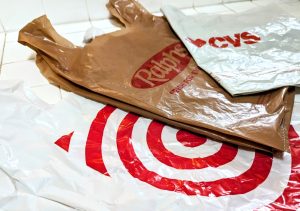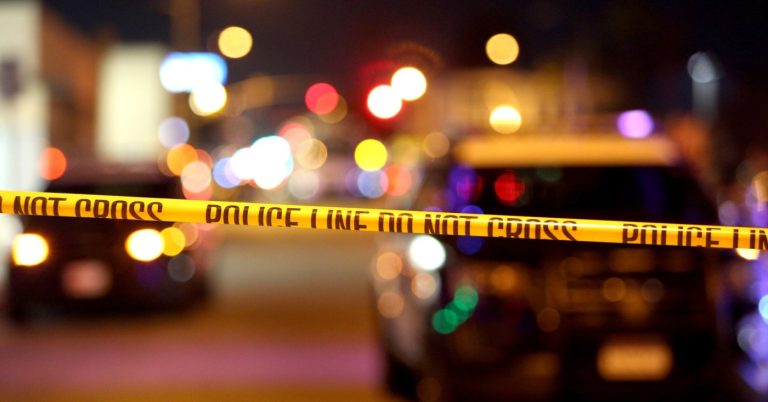Current and former Skyline High School students, from left, Felicia Tom, Mirek Hanack, Lina Nguyen, and Donna Avalos found that more than 60% said they do not eat school lunch, and nearly 80% said they do not consider school lunch healthy. (Ray Chavez/Bay Area News Group)
After a busy morning of classes, Lina Nguyen — a junior at Oakland’s Skyline High School — pulled out her lunch: a bag of Nerds gummy clusters and a Sprite.
While Oakland Unified School District offers free breakfast and lunch to all students, Nguyen said she rarely eats at her school. Instead, she chooses to occasionally bring snacks rather than brave the lunch offered on campus, which she said was known among students for being hard to access and making kids sick.
“It’s more appetizing,” Nguyen said of her sugary lunch. “I don’t really consider (school lunch) food, based off the quality. It doesn’t feel edible to me.”
She isn’t alone — Nguyen and the high school’s student leadership class surveyed about a third of the school’s 1,590 students and found that more than 60% said they do not eat school lunch and nearly 80% said they do not consider school lunch healthy.
Skyline High School’s menu offers hamburgers, chicken salad, chicken and waffles, honey sriracha wings, taco bowls, pasta, and mac and cheese. Preston Thomas, Oakland Unified’s Chief Systems and Services Officer, said most of the food at Skyline High is cooked and produced on the school’s campus. He said the district has thoroughly investigated reports of spoiled or moldy food and found no issue with the food on site.
“Food safety is really important to us,” Thomas said.
While there’s no proof the Skyline food has gotten any kids sick, and not all the polled students who don’t eat it have issues with its quality, student leaders said their survey and their own experiences point to problems with the food service the school and district need to address.
The survey was part of a larger student-led movement to improve the food at the high school, in which the students partnered with Youth Together, a nonprofit advocacy group, on a food justice campaign to demand better quality food, more accessibility and options for people with dietary restrictions at Skyline High.
“There isn’t a strong reliability in eating the cafeteria food, which is why so many students look for other options,” said Felicia Tom, a former student who graduated in June. “And for kids who can’t look for other options, they just have no choice but to basically starve themselves.”
While some Bay Area schools allow students to eat lunch off-campus, all Oakland Unified high schools — with the exception of Oakland Tech — are closed campuses, meaning students either need to bring their own lunch or eat the school’s provided food. More than 72% of Skyline’s students are classified as socioeconomically disadvantaged.
According to the U.S. Centers for Disease Control and Prevention, research shows that students who participate in school meal programs have a better overall diet quality than nonparticipants.
California became the first state to provide free school meals to all students regardless of their family income in the 2022-23 school year, with schools required to meet certain nutrition parameters to access funding.
Under the state’s Kitchen Infrastructure and Training Funds grant, California schools received $600 million to upgrade their kitchens, hire and train staff and serve high-quality, freshly cooked meals to students.
Oakland Unified said its nutrition services program operates with an annual budget of $15 million and receives federal and state funds to offer no-cost meals to every student, including $3.2 million under the kitchen infrastructure grant. The district also received $500,000 under the state’s Farm to School program to partner with local farms and provide locally sourced food in the district’s cafeterias.
Oakland Unified said it prepared a total of 80,549 lunches at Skyline High for the 2023-24 school year — amounting to nearly 500 lunches a day. That means nearly 70% of Skyline High’s students chose not to eat the school-offered lunch.
Students have complained of moldy bread, old produce and spoiled milk, and shared a video of kids laughing as they attempt to shake a clump of school macaroni and cheese off a tray.
Mirek Hanack, a Skyline senior, said he stopped eating the school’s lunch after it made him sick for a week.
“When I first came here … I was really reliant on the lunch because that was my only source of food throughout the day,” he said. “And then I got really bad food poisoning — and I knew it was from that because everything else I had, either I made or I knew the quality of.”
Skyline High students attempt to shake a clump of school macaroni and cheese off a tray. A student survey found that more than 60% said they do not eat school lunches, and nearly 80% said they do not consider school lunches healthy. (Ray Chavez/Bay Area News Group)
While his case of food poisoning wasn’t verified, Hanack said he now brings his own food to eat at school, rather than risk his “personal health.”
Thomas, the district systems and services officer, said that during the pandemic, the district received some discolored food from a supplier that students thought was moldy, but after investigating with the supplier, determined it was not mold and was safe to eat.
Food quality isn’t the only issue. Students said long lunch lines also discourage many from trying to eat the school’s food.
“I’d go straight to the lunch line and then it would take up my whole lunch and I’d barely have any time to eat,” Tom, the recent graduate, said.
Related Articles
Palo Alto Unified says battle over gender-neutral bathrooms is a misunderstanding
Hotter summers are making high school football a fatal game for some players
San Mateo schools unharmed after reports of threatening Snapchat post
Long before legal claims, California school district fielded at least 3 other complaints about its now-fired chief
East Palo Alto school worker pleads not guilty to child molestation charges
Long lines might contradict the students’ assertion that the school food is unappetizing. But Thomas acknowledged that staffing constraints and limited access points to the cafeteria have contributed to delays in moving the line quickly. The district said students have nearly 40 minutes to eat lunch, with two access points available, and more service points coming to the school this year.
The district, which recently hired a new nutritional services director at Skyline, said it is working on hiring student staff members to help prepare and distribute meals to shorten lunch lines and serve more students. Thomas said student staff could also help the campus reopen a snack bar that closed due to staffing shortages. Oakland Unified said it’s working with the students behind the food justice campaign to identify students to fill those roles.
Skyline High’s student leadership class surveyed about a third of the school’s 1,590 students and found that more than 60% said they do not eat school lunch, and nearly 80% said they do not consider lunch healthy. The student survey was part of a larger student-led movement to improve the food at the high school, in which the students partnered with Youth Together, a nonprofit advocacy group, on a food justice campaign to demand better quality food, more accessibility, and options for dietary restrictions at Skyline High. (Ray Chavez/Bay Area News Group)
He said while the campus food is healthy according to national and state requirements, the taste profile might not fit the needs of students, who are used to saltier food.
Skyline High students, including Nguyen and Hanack, said they would “100%” eat lunch on campus if the district made some changes to the quality of the food.
“I would definitely eat the school lunch if they improved the quality and make it more accessible for students,” Nguyen said.












